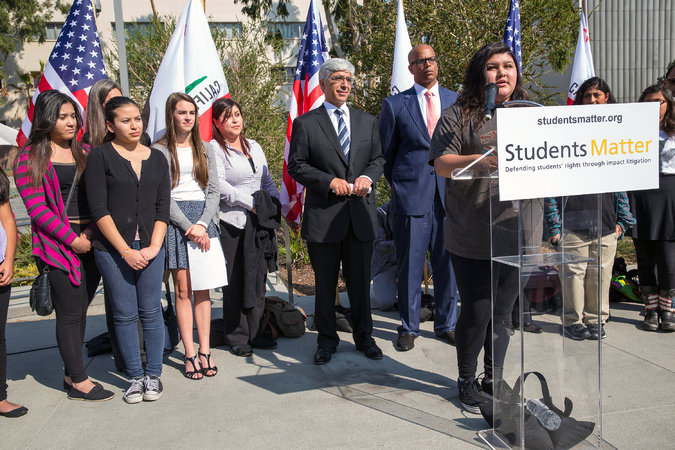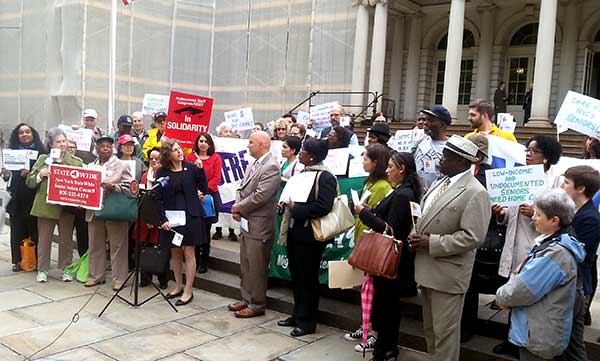Vergara's Shaky Significance

The students of Vergara (Monica Almeida/NY Times)
A June 10th lower court decision in Vergara v. California found that five California teacher employment statutes violate the State Constitution's Equal Protection Clause by disproportionately maintaining "grossly ineffective teachers...in schools serving predominantly low-income and minority students."
Speculation immediately turned to Vergara-type suits in other states with the aim of eliminating or weakening teacher tenure and other job protections across the country.
Not so fast.
The ink is hardly dry on Vergara and a lengthy appeals process awaits. Meanwhile the contested statutes remain on the books. Final victory for plaintiffs is hardly inevitable since the trial court decision shows scant evidence proving that the statutes themselves, rather than feckless administrators' failure to initiate required evaluation and termination proceedings, were the cause of plaintiffs' alleged educational injury. In addition, the court's high bar requiring the state to show a compelling interest in preserving each of the current statutes is wide open to appellate attack.
On the other hand, there is little legal traction to arguments that Vergara is over-dependent on suspect test score data and predictions that teacher quality will fall without the statutes' job security guarantees. Not that those aren't good points - but they are not legal arguments. As the court took pains to address, this case will be won or lost on legal principles of equal protection based on California precedents and facts established at trial, not policy pronouncements about the best system of teacher evaluation and due process rights for optimal educational quality. Judge Treu made clear that he believes the judicial system is too crude an instrument to decide those matters and that, under our system of separation of powers, curtailing the evidentiary parade of horribles that he said "shock the conscience" requires legislative remedies.
Which is why Vergara is more an opening for public debate - likely the main intention of the lawsuit - than it is a catalyst to directly bring about substantial changes in state or national education law. For example, Judge Treu found that California's two year probationary period prior to tenure was too short to adequately evaluate teacher quality, disproportionately penalizing poor and minority students. What if, in response, the state legislature changes that period to three years, which Vergara looks upon favorably? New fact, new case! Any or all of the statutes in question can be tweaked - cynically or not - to meet legal requirements surviving appeal.
Similarly, beyond California, any attempt to nationalize Vergara faces a tortuous path, much like the school finance battles that ensued late in the twentieth century and continue today. Each state, assuming the presence of equal protection, will have its own precedential scheme for interpreting those laws. Each will have its own constellation of teachers' employment rights. Each will have different statistical profiles of the presence or absence of incompetent teachers based on differing measures. In short, each years-long case will need to be financed and litigated individually, an extremely tall order, especially when legislative responses after any wins will have the potential to undo plaintiffs' initial expectation of educational improvement.
Remember, too, that teachers' working conditions are not generally statutory but bargained with school districts. It's even a little weird that tenure is a statutory right at all, treated as a public good rather than a private benefit. Teacher unions have been particularly successful in selling that idea so that they do not have to subject tenure, first-in-first-out, and other job protections to the give-and-take of cyclic contract negotiations.
But surely, if the Vergara plaintiffs ultimately succeed at total elimination of tenure, FIFO, etc. at the state level, the fight will just move to districts where school boards will vie with one another to offer sweet deals on job security and due process to attract the best teachers. Like white flight after Brown v. Board of Education, invoked by Judge Treu in the first line of Vergara more as a benediction than a precedent, any state-level evisceration of teacher job protections will have a negative checker-board effect on districts.
I support teacher tenure since it allows teachers uniquely necessary opportunities for classroom freedom and student advocacy that would otherwise be threatened by supervisors or public disapproval. But, with varied experience as a teacher union organizer, New York City Board of Education General Counsel, and expert witness for school districts in termination proceedings, I have too often seen procedural protections used as a sword to preserve ineptitude rather than, as intended, to shield professionalism.
Healthy debate is necessary over these policies and practices, including the crying need for administrators to vigorously exercise their supervisory duties toward probationary and tenured teachers alike. As a catalyst for this debate, Vergara serves a useful purpose even if, as legal mandate, it stands on shaky ground.
***
David C. Bloomfield is Professor of Education at Brooklyn College and the CUNY Graduate Center. He is the author of American Public Education Law, 2nd ed. and many other works, including an earlier column, Teacher Tenure Tantrum.
***
@GothamGazette
New York City Must Care for Seniors

Council Member Helen Rosenthal speaks at a rally in support of seniors (ALIGN)
Take a close look around your neighborhood and your house of worship and you'll see an aging city. New York, like the rest of the country, is experiencing an unprecedented age wave, as Baby Boomers grow older and life expectancy rises. By 2030 - in 15 years - one out of every five New Yorkers will be a senior.
With this major demographic shift, the need for home care is rising dramatically. Approximately two-thirds of seniors need some form of long term care at some point in their lives. Many are like a 92 year-old member of B'nai Jeshurun we met recently who is struggling to age in place with dignity. She would like to live independently in her home for as long as possible, but the simple physical tasks of daily life are becoming too difficult to manage. She cannot rely only on help from family and friends, and she cannot afford home care services. There are many people like this senior, whose incomes are too low to pay for home care out-of-pocket, but slightly too high to qualify for services through Medicaid.
Seniors should be able to age in place - in their homes - maintaining their lifelong connections to friends and community. As Rabbi Abraham J. Heschel says, "A test of a people is how it behaves toward the old."
As neighbors and people of conscience, we must come together to meet the challenges of caring for seniors.
One small program that has been helping New York City meet these challenges is the Expanded In-Home Services for the Elderly Program (EISEP). It helps low and moderate-income seniors over the age of 60 who are above the Medicaid threshold pay for part-time home care services. It also provides home care to undocumented seniors, who do not qualify for federal programs like Medicaid even if they are below the poverty line. Unfortunately, in 2008, City funding for EISEP was drastically cut. In 2008, City funding was at $15 million a year, and today it is at less than $5 million. What was once a robust program currently serves fewer than 3,000 seniors with care needs; that is less than 4 percent of the seniors who could benefit from the program. And the wait list for services is long.
As a first step, the City should increase funding for this vital program. Just this week, the City Council requested that the Mayor include an additional $1.8 million in this year's budget, which would ensure that the 240 seniors on the waitlist are able to receive home care services.
Beyond restoring some funding this year, we need an expanded and sustainable long-term investment in seniors and home care services. Investing more in care for seniors will benefit low-income and undocumented seniors, family caregivers who often juggle work and arranging care for a loved one, and home care workers who earn a living wage working with EISEP clients.
Many of us are dealing with difficult family situations - whether it's how to care for an ailing parent, or planning and saving for our own future care needs. At times it can seem like a private struggle, but we are not alone. By 2030, close to one million New York City seniors could need home care. It's time we heed Rabbi Heschel and start preparing for how we, as a society, will ensure dignity, respect and a decent quality of life for both caregivers and those who receive care.
***
Helen Rosenthal represents New York City's 6th City Council District and Marilyn Williams is a member of B'nai Jeshurun and a leader in the Elder Care Dialogues.
***
@GothamGazette
Closer to Home

A family visit made possible by the Osborne Association
The evidence that children love and need their parents is all around us. That evidence is a lot less visible when it comes to the 80,000 children with a parent in one of New York's 57 prisons. Maybe that's because most of our prisons are located far from the urban centers where most of our prisoners' families live.
Last week the Senate Crime Victims, Crime and Corrections Committee passed a bill (S.1789A) that we have worked on together, along with Assemblyman Crespo in his chamber, for nearly two years now. It brings New York State correctional policies in line with extensive research that shows the positive impact of making, mending and maintaining family relationships both for children and their incarcerated parents. The committee voted in support of the Proximity Pilot Bill, which would add "proximity to children" to the criteria to be considered by the Department of Corrections and Community Supervision (DOCCS) when deciding where an incarcerated person should serve his or her sentence. Current criteria includes security, mental health and other services, and availability of beds.
This pilot would add proximity to children as a factor to consider for 100 incarcerated parents who meet a set of determined criteria. The Assembly Corrections Committee approved this bill in March.
Distance is the number one barrier to children and families visiting an incarcerated parent or loved one. To their credit, the Legislature and DOCCS supported the establishment of a video visiting program with the Osborne Association, a community organization serving the incarcerated and their children and families. While this program offers real benefits to children and families, it cannot be considered a substitute for children being physically embraced by their parents. In-person visiting is critical not only for the well-being of children, but also to the success of parents when they return home. Family visitation is an effective and valuable anti-recidivism strategy and a public safety strategy.
In his support for this bill last week, Committee Chair Senator Patrick Gallivan recognized that this is a statewide issue: the demographics of the state's incarcerated population are shifting. Just half of women in our prisons are from New York City and its suburbs; 50 percent are from other parts of the state. The demographics of incarcerated men are similar. There are mothers and fathers from Western New York who are incarcerated within an hour of New York City; their children are suffering and their own likelihood of successful re-entry is weakened by not maintaining family ties.
Adding proximity to the calculus is in all of our best interests. People returning from prison are less likely to again commit crimes and are more likely to contribute productively to society when their family relationships are intact. Despite this, DOCCS' current practice seems to favor incarcerating someone far away from home, bringing them closer to home as they near release. But by that time, relationships have already been damaged by distance, and family support diminished. Far too often, the legacy of incarceration is severed relationships, with children also paying a hefty price.
It is time for our state correctional policies to reflect what research continues to confirm: that family connectedness – best achieved through visiting – is integral to successful re-entry, lower recidivism rates, and better outcomes for children. We join together to call on the State Legislature to bring this bill to the floor in both Houses and pass it.
***
Gustavo Rivera is the New York State Senator for the 33rd Senate District, which extends from the Northwest Bronx to areas of the East Bronx. He serves on the Crime Victims, Crime and Corrections Committee.
Elizabeth Gaynes is Executive Director of the Osborne Association, one the country's largest and most effective nonprofit organizations serving individuals affected by crime and incarceration. Follow Osborne on Twitter @osborneny
***
@GothamGazette




